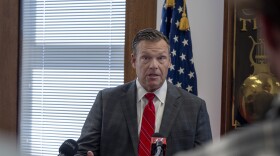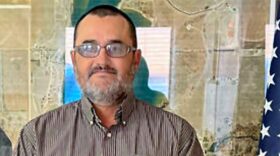Hospitals in Kansas and elsewhere have been turning to overseas workers as a way to combat the ever-worsening shortage of nurses, but decades-old federal immigration rules are now getting in the way.
Researchers estimate that the U.S. health care system will be short 200,000 to 450,000 nurses in 2025.
In Kansas, hospitals have been looking to the Philippines, trying to attract people like Regina Ancola from the nation’s robust nursing workforce.
She came to the United States from the Philippines in the 1970s to work as a nurse in a Kansas City area hospital.
“When I was in my first three years, I worked three hospitals so I can buy the house for my mom and dad, pay all the debt and everything,” Ancola said in an interview. “That’s how we do it.”
But delays in worker visa processing, and caps on the number of visas, are now getting in the way. Hospitals are scrambling to fill workforce gaps and trying to keep nurses interested in Kansas before they are snatched up by other countries.
Workforce shortage
Kansas recruiters are looking as far away as the Philippines in Southeast Asia because 21% of registered nursing jobs in the state went unfilled last year. That’s what the Kansas Hospital Association found in a recent report.
“Just to kind of put that in perspective, we need four nurses on a unit,” said Cindy Samuelson with the KHA. “If we’re thinking of percentages 25%, that means we only have three.”
Prior to the pandemic, the U.S. was already experiencing a shortage of nurses. During COVID-19, the issue was only exacerbated as fatigued nurses left the workforce.
Samuelson said the association held its very first virtual job fair to try to reach more potential workers. The group is also partnering with the Kansas Chamber of Commerce and rural organizations to raise awareness of the job opportunities in the medical field.
“It’s one of the industries in our state that’s continuing to grow and evolve,” Samuelson said.
The job vacancies keep piling up because of retirements, burnout from the pandemic and increased demand for medical services.
Stormont Vail Health System in Topeka is one of the facilities looking abroad for ways to fill the shortage.
International Recruitment Manager Tiffany Beyer said the hospital sent three employees to the Philippines last year to recruit nurses.
“They got to meet them, hear about their families, their experiences, their desire to come to the United States,” Beyer said. “We did a lot of offers right there on the spot.”
More than 100 nurses accepted job offers. The expected arrival of the first group of employees was planned for this fall.
But then the plan came to a grinding halt as the U.S. government announced a pause in the processing of recent visa applications in April while it tried to clear a backlog.
“We were shocked and disappointed,” Beyer said, describing the moment she heard the news. “Nobody anticipated that.”
It’s now unclear how long the delay could last.
“It’s almost impossible to predict,” she said. “We’ve heard 2024. We’ve heard 2025.”
The Topeka hospital isn’t the only one dealing with this issue. Henry Ford Health in Michigan is also in the process of hiring nurses from the Philippines.
Chief Nursing Officer Eric Wallis said the facility is waiting on more than 400 nurses who accepted jobs and is planning to hire about 200 more later this year.
“We know that they’re not all going to come at once,” Wallis said. “They’re going to be spread out over time. And so between them coming and what we would assume to be natural kind of attrition within our workforce, we think that that 600 number is going to get us into a pretty good place.”
He said the hospital in southeast Michigan is also increasing efforts to recruit American nurses by partnering with Michigan State University to train new talent.
“It is a multi-pronged approach,” Wallis said. “There is no one silver bullet that's going to help us solve the nursing shortage in the U.S.”
One nurse did arrive this spring, but the rest of their recent hires are in limbo waiting to see when their visa application might be reviewed.
“It’s disappointing for those nurses who are in the Philippines who want to come, because this is life changing for them and their families,” Wallis said.
An outdated immigration system
A bowl filled with currency from all over the world sits on immigration lawyer James Austin’s desk. He has it there for his clients to look through and maybe find a coin from their homeland.
Austin has been practicing for about 30 years and has found visa backlogs to be a common challenge.
“It’s only been in the last four or five years that there was not a waiting period,” he said. “So a waiting period is more of the norm. And we’ve just gone back to the norm.”
What’s new is the continual rising demand for foreign workers. But the limit on visas hasn’t grown with that.
The Immigration Act of 1990 majorly restructured the U.S. immigration system for the first time since the Immigration and Nationality Act of 1965.
It established family-based, employer-based and a diversity lottery type visa option. Also referred to as green cards, the visas gave permanent immigration status.
The employer-based visa is broken into different categories based on the skill level needed for the job. Nurses fall into the EB3 category due to the job qualifications.
But nurses are not the only profession to fall into the third category. Austin said teachers, information technology workers and other medical professionals are also applying for the same category.
“Nurses are actually a very small part of that,” Austin said. “They're competing with all these other professions for those limited number of visas, which makes it even tougher for nurses.”
Mira Mdivani provides legal counsel to hospitals recruiting staff from around the world. She said Congress needs to remove what she sees as arbitrary caps.
“Our immigration system is outdated and ridiculous,” Mdvani said.
For some businesses and companies, the visa application process can take over a decade.
“Our clients, hospitals who are needing hundreds and thousands of nurses to take care of patients, especially in the Midwest, are now set back because the nurses that are supposed to be arriving now cannot be interviewed at the consulates,” she said. “As a result, hospitals are suffering, patients suffering.”
Mdivani said yearly visa limits put American hospitals at a disadvantage in the international market for nurses.
“These nurses have options,” Mdvani said. “These nurses can go to Europe. They can go to the Middle East.”
Keeping nurses interested
Beyer at Stormont Vail said the hospital keeps in touch with the new hires with messages from the hospital president.
“We have monthly Zooms with all of our nurses,” she said. “We send them weekly emails and Dr. Kenagy’s updates and things like that to keep them feeling part of our Stormont Vail family.”
She said the hospital continues with preparations in hopes of the nurses arriving.
Wallis at Henry Ford Health said the hospital is also keeping in touch with its potential new employees but staff are also pushing U.S. lawmakers to address the issue.
“They can open up additional EB3 visas, just for nurses,” said Wallis. “And that’s really what we have advocated for is to be a little more surgical in that approach.”
Just as an individual might lose interest sitting and waiting for a table at a restaurant, Wallis said there are fears that Filipino nurses already committed to working at the hospital might start looking elsewhere.
“We haven’t seen that at this point,” Wallis said. “And we’re really excited and happy about that. But that is certainly a risk at this moment.”
Samantha Horton reports on health for the Kansas News Service. You can follow her on Twitter @SamHorton5.
The Kansas News Service is a collaboration of KCUR, Kansas Public Radio, KMUW and High Plains Public Radio focused on health, the social determinants of health and their connection to public policy.
Kansas News Service stories and photos may be republished by news media at no cost with proper attribution and a link to ksnewsservice.org.
Copyright 2023 KCUR 89.3. To see more, visit KCUR 89.3. 9(MDA4OTAxNzAzMDEzMjc0MTc2MzA5ZDZlMw004))







